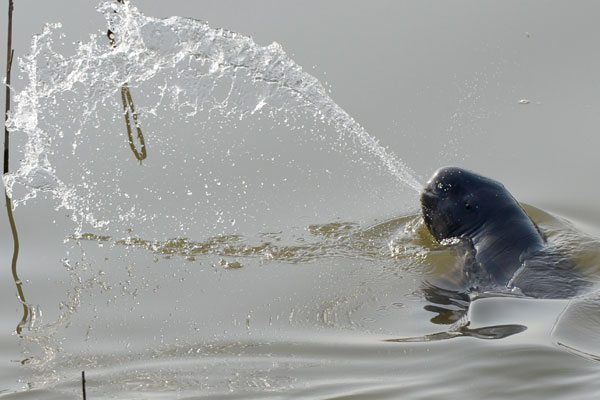Call for protection of finless porpoise
Updated: 2012-12-10 10:30
(Xinhua)
|
||||||||
HEFEI - Experts involved in a scientific survey said China's finless porpoise population has dropped significantly in the past few years, and they called for top protection of the endangered animal.
Statistics from the survey conducted on a section of the Yangtze River in November show that the number of finless porpoises, or "river pigs," as they are known locally, has declined about 60 percent since 2006, said Wang Kexiong, an associate researcher with the Institute of Hydrobiology, Chinese Academy of Sciences (CAS).
 |
|
A finless porpoise swims in a natural reserved area in Tongling, Anhui province on Dec 4. [Photo/Xinhua] |
"Judging from the survey results, the living conditions of finless porpoises are not good," said Wang, who is also deputy director of the survey team.
Experts say there are only about 1,000 finless porpoises left, making them more rare than the giant panda. The freshwater mammal's population is shrinking at an annual rate of more than 5 percent.
The finless porpoise lives exclusively in the Yangtze River and the Poyang and Dongting lakes, which are both linked to the waterway.
In March and April, at least 10 finless porpoises were reported dead in Dongting Lake in Hunan province, and another six have died since the beginning of this year in Poyang Lake in Jiangxi province, according to local fishery authorities.
The deaths triggered wide concern over the species' living conditions. Experts say the animals are facing threats stemming from human activities such as shipping, sand dredging and illegal fishing, as well as climate change and water pollution.
"The conflicts between the protection of finless porpoises and the exploitation of the Yangtze River resources are outstanding," said Wang.
The Yangtze River, also known as China's "golden waterway," serves as a major transportation artery for the economies along the river. About 85 percent of coal and iron ore and 95 percent of export commodities in the upper- and middle-reaches are transported via the river.
The Ministry of Agriculture has appealed to the State Council, asking the Cabinet list the animal under first-grade protection at the state level, according to Wang.
"Once approved, there will be more regulations and laws to limit human activities in areas where finless porpoises live," Wang said.
However, totally banning shipping along the river is unrealistic, Wang said.
Relocating the animals to safer waters or putting them in artificial breeding programs are alternative protection methods, said Zhang Xinqiao, a World Wildlife Fund (WWF) expert who is also part of the survey team.
The survey was launched from the Central China city of Wuhan along the Yangtze River on November 11 amid worries that the finless porpoise may be on the verge of extinction.
Consisting of researchers from the Ministry of Agriculture, the CAS and the WWF, the 40-day survey was the most comprehensive of its kind since 2006, when a survey found that the number of finless porpoises had fallen to 1,800 and pronounced the white-flag dolphin, a larger mammal also native to the river, close to extinction.

 Relief reaches isolated village
Relief reaches isolated village
 Rainfall poses new threats to quake-hit region
Rainfall poses new threats to quake-hit region
 Funerals begin for Boston bombing victims
Funerals begin for Boston bombing victims
 Quake takeaway from China's Air Force
Quake takeaway from China's Air Force
 Obama celebrates young inventors at science fair
Obama celebrates young inventors at science fair
 Earth Day marked around the world
Earth Day marked around the world
 Volunteer team helping students find sense of normalcy
Volunteer team helping students find sense of normalcy
 Ethnic groups quick to join rescue efforts
Ethnic groups quick to join rescue efforts
Most Viewed
Editor's Picks

|

|

|

|

|

|
Today's Top News
Health new priority for quake zone
Xi meets US top military officer
Japan's boats driven out of Diaoyu
China mulls online shopping legislation
Bird flu death toll rises to 22
Putin appoints new ambassador to China
Japanese ships blocked from Diaoyu Islands
Inspired by Guan, more Chinese pick up golf
US Weekly

|

|






